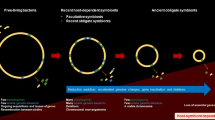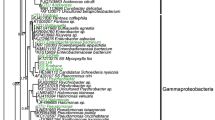Abstract
Bacterial endosymbionts of insects are increasingly being recognized as common, diverse, and integral to the biology of their hosts. Inherited fungal symbionts have been largely overlooked, however, even though insect guts appear to be a key habitat for an incredible array of fungal diversity. Like bacteria, fungal symbionts also likely play important roles in the ecology and evolution of their insect associates. The objective of this study was to lay the foundations for understanding the roles of the vertically transmitted fungal and bacterial associates of both the brownbanded cockroach, Supella longipalpa, and its parasitic wasp, Comperia merceti. We used culture-dependent and culture-independent molecular methods and phylogenetic analyses in order to identify the symbionts. Two fungal associates of brownbanded cockroaches were found. To our knowledge, this is the first record of vertically transmitted fungal symbionts in the order Blattaria. The wasp was found to house a close relative of one of the cockroach fungi but no bacterial symbionts. Finally, the brownbanded cockroaches also harbored three lineages of bacterial symbionts: Blattabacterium and two lineages of Wolbachia, indicating the number of vertically transmitted symbionts in this insect may be as many as five.



Similar content being viewed by others
References
Shigenobu S, Watanabe H, Hattori M, Sakaki Y, Ishikawa H (2000) Genome sequence of the endocellular bacterial symbiont of aphids Buchnera sp APS. Nature 407:81–86
Gaudermann P, Vogl I, Zientz E, Silva FJ, Moya A, Gross R, Dandekar T (2006) Analysis of and function predictions for previously conserved hypothetical or putative proteins in Blochmannia floridanus. BMC Microbiol 6:1
Akman L, Yamashita A, Watanabe H, Oshima K, Shiba T, Hattori M, Aksoy S (2002) Genome sequence of the endocellular obligate symbiont of tsetse flies, Wigglesworthia glossinidia. Nat Genet 32:402–407
Werren JH (1997) Biology of Wolbachia. Annu Rev Entomol 42:587–609
Zchori-Fein E, Perlman SJ, Kelly SE, Katzir N, Hunter MS (2004) Characterization of a ‘Bacteroidetes’ symbiont in Encarsia wasps (Hymenoptera: Aphelinidae): proposal of ‘Candidatus Cardinium hertigii'. Int J Syst Evol Microbiol 54:961–968
Russell JA, Moran NA (2006) Costs and benefits of symbiont infection in aphids: variation among symbionts and across temperatures. Proc R Soc B-Biol Sci 273:603–610
Oliver KM, Russell JA, Moran NA, Hunter MS (2003) Facultative bacterial symbionts in aphids confer resistance to parasitic wasps. Proc Natl Acad Sci U S A 100:1803–1807
Scarborough CL, Ferrari J, Godfray HCJ (2005) Aphid protected from pathogen by endosymbiont. Science 310:1781–1781
Suh SO, McHugh JV, Pollock DD, Blackwell M (2005) The beetle gut: a hyperdiverse source of novel yeasts. Mycol Res 109:261–265
Vega FE, Dowd PF (2005) The role of yeasts as insect endosymbionts. In: Blackwell, M, Vega FE (eds) Insect–fungal associations: Ecology and evolution. Oxford University Press, pp 211–243
LeBeck LM (1985) Unpublished doctoral dissertation. University of California, Riverside
Fathpour H, Emtiazi G, Ghasemi E (2003) Cockroaches as reservoirs and vectors of drug resistant Salmonella spp. Fresenius Environ Bull 12:724–727
Manweiler SA (1988) Two parasites of the brownbanded cockroach: a competition matrix. University of California, Berkeley
Coler RR, Vandriesche RG, Elkinton JS (1984) Effect of an oothecal parasitoid, Comperia merceti (Compere) (Hymenoptera: Encyrtidae), on a population of the brownbanded cockroach (Orthoptera: Blattellidae). Environ Entomol 13:603–606
Lebeck LM (1989) Extracellular Symbiosis of a yeast-like microorganism within Comperia merceti (Hymenoptera: Encyrtidae). Symbiosis 7:51–66
Suh SO, Gibson CM, Blackwell M (2004) Metschnikowia chrysoperlae sp nov., Candida picachoensis sp nov. and Candida pimensis sp nov., isolated from the green lacewings Chrysoperla comanche and Chrysoperla carnea (Neuroptera: Chrysopidae). Int J Syst Evol Microbiol 54:1883–1890
Munson MA, Baumann P, Clark MA, Baumann L, Moran NA, Voegtlin DJ, Campbell BC (1991) Evidence for the establishment of aphid-eubacterium endosymbiosis in an ancestor of 4 aphid families. J Bacteriol 173:6321–6324
Hausner G, Reid J, Klassen GR (1993) On the phylogeny of Ophiostoma, Ceratocystis-Ss, and Microascus, and relationships within Ophiostoma based on partial ribosomal DNA-sequences. Can J Bot 71:1249–1265
Vilgalys R, Hester M (1990) Rapid genetic identification and mapping of enzymatically amplified ribosomal DNA from several Cryptococcus species. J Bacteriol 172:4238–4246
White TJ, Bruns T, Lee S, Taylor J (1990) Amplification and direct sequencing of fungal ribosomal RNA genes for phylogenetics. In: PCR Protocols: A guide to methods and applications. Academic, New York, pp 315–322
Kurtzman CP, Robnett CJ (1998) Identification and phylogeny of ascomycetous yeasts from analysis of nuclear large subunit (26S) ribosomal DNA partial sequences. Antonie van Leeuwenhoek 73:331–371
Edgar RC (2004) MUSCLE: multiple sequence alignment with high accuracy and high throughput. Nucleic Acids Res 32:1792–1797
Maddison DR, Maddison WP (2005) MacClade v2.08 for OSX
Ronquist F, Huelsenbeck JP (2003) MrBayes 3: Bayesian phylogenetic inference under mixed models. Bioinformatics 19:1572–1574
Posada D, Crandall KA (1998) MODELTEST: testing the model of DNA substitution. Bioinformatics 14:817–818
Swofford D (1996) PAUP*: Phylogenetic analysis using parsimony and other methods
Rambaut A, Drummond AJ (2007) Tracer v1.4
Maddison WP, Maddison DR (2005) Mesquite v1.06 beta
Vaishampayan PA, Dhotre DP, Gupta RP, Lalwani P, Ghate H, Patole MS, Shouche YS (2007) Molecular evidence and phylogenetic affiliations of Wolbachia in cockroaches. Mol Phylogenet Evol 44:1346–1351
Wren HN, Cochran DG (1987) Xanthine dehydrogenase activity in the cockroach endosymbiont Blattabacterium cuenoti (Mercier 1906) Hollande and Favre 1931 and in the cockroach fat body. Comp Biochem Physiol B 88:1023–1026
Henry SM (1962) The significance of microorganisms in the nutrition of insects. Trans N Y Acad Sci 77:676–683
Lipke H, Leto S, Graves B (1965) Carbohydrate-amino acid conversions during cuticle synthesis in Periplaneta americana. J Insect Physiol 11:1225–1232
Lo N, Bandi C, Watanabe H, Nalepa C, Beninati T (2003) Evidence for cocladogenesis between diverse dictyopteran lineages and their intracellular endosymbionts. Mol Biol Evol 20:907–913
Inward D, Beccaloni G, Eggleton P (2007) Death of an order: a comprehensive molecular phylogenetic study confirms that termites are eusocial cockroaches. Biol Lett-UK 3:331–335
Stouthamer R, Breeuwer JAJ, Hurst GDD (1999) Wolbachia pipientis: Microbial manipulator of arthropod reproduction. Annu Rev Microbiol 53:71–102
Zabalou S, Riegler M, Theodorakopoulou M, Stauffer C, Savakis C, Bourtzis K (2004) Wolbachia-induced cytoplasmic incompatibility as a means for insect pest population control. Proc Natl Acad Sci USA 101:15042–15045
Hoffmann AA, Clancy D, Duncan J (1996) Naturally-occurring Wolbachia infection in Drosophila simulans that does not cause cytoplasmic incompatibility. Heredity 76:1–8
Dedeine F, Vavre F, Fleury F, Loppin B, Hochberg ME, Bouletreau M (2001) Removing symbiotic Wolbachia bacteria specifically inhibits oogenesis in a parasitic wasp. Proc Natl Acad Sci USA 98:6247–6252
Baldo L, Werren JH (2007) Revisiting Wolbachia supergroup typing based on WSP: Spurious lineages and discordance with MLST. Curr Microbiol 55:81–87
Baldo L, Prendini L, Corthals A, Werren JH (2007) Wolbachia are present in Southern African scorpions and cluster with supergroup F. Curr Microbiol 55:367–373
Dunn AK, Stabb EV (2005) Culture-independent characterization of the microbiota of the ant lion Myrmeleon mobilis (Neuroptera: Myrmeleontidae). Appl Environ Microb 71:8784–8794
Kondo N, Shimada M, Fukatsu T (2005) Infection density of Wolbachia endosymbiont affected by co-infection and host genotype. Biol Lett-UK 1:488–491
Mouton L, Dedeine F, Henri H, Bouletreau M, Profizi N, Vavre F (2004) Virulence, multiple infections and regulation of symbiotic population in the Wolbachia-Asobara tabida symbiosis. Genetics 168:181–189
Narita S, Nomura M, Kageyama D (2007) Naturally occurring single and double infection with Wolbachia strains in the butterfly Eurema hecabe: transmission efficiencies and population density dynamics of each Wolbachia strain. FEMS Microbiol Ecol 61:235–245
Viljakainen L, Reuter M, Pamilo P (2008) Wolbachia transmission dynamics in Formica wood ants. Bmc Evol Biol 8
Dedeine F, Vavre F, Shoemaker DD, Bouletreau M (2004) Intra-individual coexistence of a Wolbachia strain required for host oogenesis with two strains inducing cytoplasmic incompatibility in the wasp Asobara tabida. Evolution 58:2167–2174
Suh SO, Nguyen NH, Blackwell M (2008) Yeasts isolated from plant-associated beetles and other insects: seven novel Candida species near Candida albicans. FEMS Yeast Res 8:88–102
Porter TM, Schadt CW, Rizvi L, Martin AP, Schmidt SK, Scott-Denton L, Vilgalys R, Moncalvo JM (2008) Widespread occurrence and phylogenetic placement of a soil clone group adds a prominent new branch to the fungal tree of life. Mol Phylogenet Evol 46:635–644
McCutcheon JP, Moran NA (2007) Parallel genomic evolution and metabolic interdependence in an ancient symbiosis. Proc Natl Acad Sci U S A 104:19392–19397
Lachance MA, Ewing CP, Bowles JM, Starmer WT (2005) Metschnikowia hamakuensis sp nov., Metschnikowia kamakouana sp nov. and Metschnikowia mauinuiana sp nov., three endemic yeasts from Hawaiian nitidulid beetles. Int J Syst Evol Microbiol 55:1369–1377
Bull JJ (1983) Evolution of sex determining mechanisms. Bejamin/Cummings, Menlo Park, CA
Roth LM, Willis ER (1957) The medical and veterinary importance of cockroaches. Smithson Misc Collect 134:147
Crump A (1993) Dictionary of environment and development: People, places, ideas and organizations. MIT press, Cambridge, Mass
Bell WJ, Roth LM, Nalepa CA (2007) Cockroaches: Ecology, behavior, and natural history. Johns Hopkins University Press, Baltimore
Warnecke F, Luginbuhl P, Ivanova N, Ghassemian M, Richardson TH, Stege JT, Cayouette M, McHardy AC, Djordjevic G, Aboushadi N, Sorek R, Tringe SG, Podar M, Martin HG, Kunin V, Dalevi D, Madejska J, Kirton E, Platt D, Szeto E, Salamov A, Barry K, Mikhailova N, Kyrpides NC, Matson EG, Ottesen EA, Zhang XN, Hernandez M, Murillo C, Acosta LG, Rigoutsos I, Tamayo G, Green BD, Chang C, Rubin EM, Mathur EJ, Robertson DE, Hugenholtz P, Leadbetter JR (2007) Metagenomic and functional analysis of hindgut microbiota of a wood-feeding higher termite. Nature 450:560-U517
Thrall PH, Hochberg ME, Burdon JJ, Bever JD (2007) Coevolution of symbiotic mutualists and parasites in a community context. Trends Ecol Evol 22:120–126
Acknowledgements
The University of Arizona Departments of Entomology, Ecology and Evolutionary Biology, and Molecular and Cellular Biology supported CMG while conducting this research. In addition, CMG received two small grants: a Mycological Society of America Graduate Fellowship Award and a Center for Insect Science Graduate Student Research Award. This project was supported by the National Research Initiative of the Cooperative State Research, Education and Extension Service, grant (2006-35302-17165), and a National Science Foundation grant (DEB-0542961), both to MSH. We would like to thank M. Hoffman, J. U’Ren, C. Schmidt, A. Swanson, A. Wild, and D. Maddison for helpful discussions about the phylogenetic analysis. We would also like to thank the Hunter Lab Group, J. U’Ren, and two anonymous reviewers for comments on previous drafts of the manuscript and R. VanDriesche for sending us C. merceti.
Author information
Authors and Affiliations
Corresponding author
Rights and permissions
About this article
Cite this article
Gibson, C.M., Hunter, M.S. Inherited Fungal and Bacterial Endosymbionts of a Parasitic Wasp and Its Cockroach Host. Microb Ecol 57, 542–549 (2009). https://doi.org/10.1007/s00248-008-9436-1
Received:
Accepted:
Published:
Issue Date:
DOI: https://doi.org/10.1007/s00248-008-9436-1




